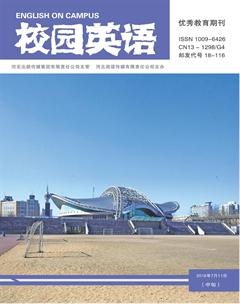The Cognitive Research of Multimodal metaphor in the Animated film “Frozen”
李晓鹤
【Abstract】Metaphor is a cognitive process with vitality, through which we can understand one thing based on another thing. The muitimodal metaphor combines the metaphor which is ordinary form of language with image, music, action and nonverbal sound together. Thus, the way of expression is more diverse, more vivid. “Frozen” is animation movie which breaks the traditional fairy tale. The essay regards the famous film “Frozen” as the object of study. The author will analysis some certain plot in the film from the perspective of the multimodal metaphor to explore the application of multimodal metaphor in the film.
【Key words】conceptual metaphors; Multimodal metaphor; Animation films; Frozen
The conceptual metaphor theory was first introduced by Lakoff and Johnson in their coauthored book—“The metaphor we live by”. The important role of metaphor is to help people to understand the abstract and complicated concept with the simple and concentrate concept. In the 1990s, the media scholar Charles Forceville, from the university of Amsterdam in the Netherlands first explores the picture metaphor in advertising from the visual lever in his book “the picture metaphor in advertising”. This great change not only breaks the previous limit, but also puts forward the multimodal metaphor theory. Under his leading, many scholars in the filed begin to extend their study to the field of music, television and teaching and so on.
1. About the multimodal metaphor theory
Multimodal metaphor is a relative concept with regards to mono-modal. Its research is focused on the use of modal. The multimodal metaphor refers to the source domain and the target domain respectively or mainly use different kinds of modals to present the metaphor phenomenon. To get a comprehensive understanding of multimodal metaphor, first of all, understanding of multimodal is indispensable. The different forms of perception that are used to communicate can be called a “modal”. People tend to use different organs to perceive modal. It is mainly composed of 5 kinds of modes: visual , audio , touch, smell,and hearing modal. In addition, people tend to mix the five modals.
2. The multimodal metaphor analysis in “Frozen”
2.1 The source domain and the target domain
According to Lakoff, metaphor can be divided into structural metaphor , orientation metaphor and entity metaphor. Based on his assumption, “up-down”, “forward-backward”, “indoors-outdoors”, “deep-shallow” and so on, they are all the basic concepts. In terms of “indoors-outdoors” schemata, if the thing or the character is outside, then to some extent, it suggests the thing or the character is squeezed out. In “Frozen”, the king ordered the servants to shut the gates in order to keep the secret of Elsa' having magic. Thus, “shut the gates” hints that the kingdom will choose to close themselves without contacting with the outside world.
2.2 The multimodal metaphor that is interacted by the Image modal and sound modal
In the beginning of the film, there is a stunning song of digging up the ice. Thousands of labors defy cold, hard and lonely ice and insist on their working. The film starts with thus an ingenious beginning to attract the audience's curiosity. By using the image modal and sound modal, the film successfully presents a picture of powerful labors' working and their character.
3. Conclusion
In a sense, The audience can clearly understand the underlying meaning that is from source domain to target domain by integrated using of kinds of modals. In this paper, the author analyses the metaphor from the perspective of image modal, voice modal and so on. Thus, we can appreciate the film plot better. At the same time, the multimodal metaphor provides a new perspective in terms of analysis animation film.
References:
[1]Forceville C. Pictorial Metaphor in Advertising [M]. London: Routledge,1996:108.
[2]Forceville, C.Non-verbal and Multimodal Metaphor in a Cognitivist Framework: Agendas for Research [A]. Forceville, C&E. Urios-Aparisi. Multimodal Metaphor [C]. Berlin/New York: Mouton de Gruyter, 2009.
[3]Lakoff G.Johnson M. Metaphor We Live By [M] Chicago: University of Chicago Press,1980:11-13.
[4]Whittock, T. Metaphor and film[M].Cambridge: Cambridge University Press, 1990.

